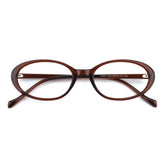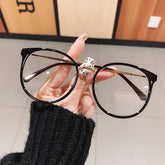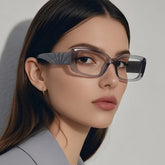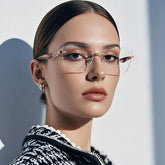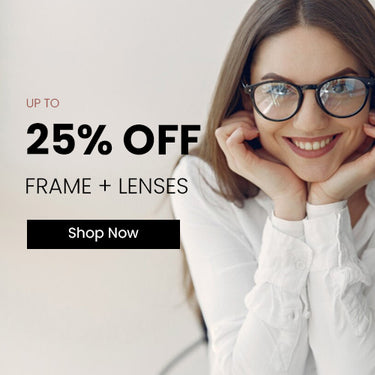Myopia vs. Hyperopia: What Is the Difference?
With a normal-shaped eye, when light enters, it refracts or bends and focuses on the retina (the light-sensitive tissue at the back of the eye), resulting in a clear image. However, in a refractive error, an irregularly shaped eye prevents light from focusing directly on the retina, leading to blurry vision. Myopia and hyperopia are both refractive errors that affect vision, but they affect different distances. Myopia, or nearsightedness, causes blurry vision at a distance, while hyperopia, or farsightedness, causes blurry vision up close. Recognizing and addressing them is essential for maintaining good eye health and preventing vision from worsening.
- Myopia and Hyperopia
- What's the difference between myopia and hyperopia?
- How to choose the glasses?
1. Myopia and Hyperopia
- Myopia, also known as nearsightedness, refers to the focal point falling in front of the retina: the eyeball is too long or the corneal/crystalline lens has too strong refractive power, causing distant objects to blur while nearby objects are clear. Your risk of developing myopia is higher if a family member is myopic.
- Hyperopia, or farsightedness, is the opposite of myopia. It refers to the condition where the focus falls behind the retina: the eyeball is too short or the refractive power is insufficient, and light cannot be focused on the retina. People with mild hyperopia can see clearly in the distance through eye adjustment, but both the near and far areas may be blurred. Children with astigmatism may be at a higher risk of other eye conditions, such as lazy eye.
2. What's the difference between myopia and hyperopia?
Causes
The main problem of myopia is that the eyeball is too long (axial myopia) or the refractive system is too strong (refractive myopia), causing light to focus in front of the retina. It may be caused by various reasons.
- Genetic factors: Parents having myopia may increase the likelihood of their children developing myopia.
- Environmental factors: Prolonged close reading and computer use can lead to an increase in eye axis adaptability; also, insufficient outdoor activities may affect eye development.
The core problem of hyperopia is that the eyeball is too short (axial hyperopia) or the refractive system is too weak (refractive hyperopia), causing light to focus behind the retina.
- For infants and young children, they have shorter eyeballs, which belongs to normal physiological hyperopia, and symptoms will alleviate with growth.
- For adults, with age, the ability to regulate the eyes decreases and symptoms of farsightedness appear.
Impacts
The prominent feature of myopia is blurred vision at a distance and clear vision at a close distance, so it relies on glasses. High myopia (>600 degrees) may be accompanied by poor night vision and glare.
The characteristic of hyperopia is blurred near vision but clear far vision. Due to continuous eye adjustment, the eye's ability is exhausted, leading to visual fatigue and headaches. If high hyperopia in children is not corrected in a timely manner, it may lead to delayed visual development.
Symptoms
Although they are different conditions, myopia and hyperopia have several common symptoms. Early detection and treatment are key to effectively managing these diseases.
Blurred vision
- Myopia: unable to see objects up to 5 meters away clearly (such as blackboards, road signs, and TV subtitles); need to squint or frown to barely see distant targets.
- Hyperopia: When reading, books should be held far away (>40cm); the font on the phone needs to be enlarged to be clear.
Visual fatigue
- Eye swelling and headache after prolonged use of the eyes
- Significant decrease in night vision (difficulty driving at night)
- Temporary blurred vision
Characteristic behavior
- Move your seat forward continuously while watching TV.
- Habitual eye rubbing and increased blink frequency
3. How to choose the glasses?
Glasses are the most common and easiest solution for vision correction. They come in various styles and prescriptions to suit vision needs and fashion preferences. Myopia and hyperopia have different needs when choosing lenses. Choosing lenses that suit oneself can alleviate visual fatigue.
People with myopia who face electronic screens for a long time can choose anti-blue-light lenses. People with myopia who enjoy outdoor activities can choose color-changing lenses to prevent damage to their glasses from sunlight. For people with presbyopia and farsightedness, progressive multifocal lenses are needed to solve the problem of looking far and close. If it is hyperopia in children, priority should be given to impact-resistant materials (such as PC lenses).
Wearing glasses will have an adaptation period, and treating the adaptation period correctly can help identify potential problems in a timely manner. Wearing nearsighted glasses may cause mild dizziness (especially when first wearing glasses or when the degree increases rapidly), which usually subsides within 1-2 weeks. But if the visual object is deformed, it is necessary to check whether the optical center of the lens is aligned with the pupil. Wearing farsighted glasses is more likely to cause eye soreness and headaches, as it requires the adjustment of the eyes. This phenomenon is more common when adults first wear glasses.


